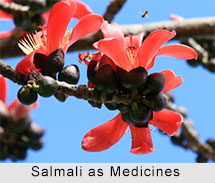 Salmali is one such important medicinal plant used in Ayurveda. All parts of this plant like flowers, exudates, thorn, leaves and root are useful in treatment of various ailments.
Salmali is one such important medicinal plant used in Ayurveda. All parts of this plant like flowers, exudates, thorn, leaves and root are useful in treatment of various ailments.
Salmali is one of the largest of our Indian trees, often about 100 feet high and the trunk thick and ramous in proportion. Flowering time the end of winter, when the tree is totally destitute of leaves. The great numbers of very large bright red flowers with which it is then covered make it remarkably conspicuous at a very great distance. The thick stems are used for making large boats called "Kondas", from their being made by hollowing out the trunks. Some of these boats are large enough to carry a freight of a thousand mounds. The smaller floats are in very common use in Eastern Bengal, for crossing over rice fields during the rainy season. In fact during the rains these little floats constitute the only mode of conveyance from village to village in low alluvial tracts. The thick, beds and pillows of the natives are stuffed with the Cotton attached to the interior of the seed vessels of this plant, while the thin quilts and stuffed clothing for winter, are made with karpasa (cotton of Gossypium herbaceum).
Health Benefits of Salmali
In Ayurveda it is referred as aphrodisiac, astringent, anti-diarrhoeal, anti-dysenteric, antimicrobial diuretic, alterative, antipyretic and tonic. It is used in treatment of asthma, diarrhoea, wound, leucorrhoea, anaemia, seminal disorders and skin problems.
Dose of Salmali in Medicine
The gum of this tree, called "Mocha Rasa" is used in medicine. It is considered astringent, tonic and alterative, and is used in diarrhoea, dysentery and menorrhagia. Mocha Rasa with sugar in equal parts, is given in doses of 20 to 40 grains, in the diarrhoea of children.
In the dysentery of children, the following is used; take Mocha Rasa, flowers of Woodfordia floribunda (dhataki), root of Mimosa pudica (lajjalu) and the filaments of the lotus in equal parts, in all one tola, powdered rice one tola, water 11 tolas and boil together to the consistence of gruel (yavagu). In the dysentery of adults a decoction of bela fruit in goat"s milk is given with the addition of powdered Mocha Rasa and indrajava seeds.
Related Articles
Ayurveda
History of Ayurveda
Origin of Ayurveda
Ayurveda Medication
Elements of Ayurveda
Concepts of Ayurveda
Ancient Literature of Ayurveda
Sushruta Samhita




















